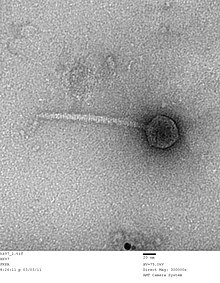
Siphoviridae
| Siphoviridae | |
|---|---|

| |
| TME picture of an Escherichia virus HK97 virion, Siphoviridae | |
|
Virus classification | |
| (unranked): | Virus |
| Realm: | Duplodnaviria |
| Kingdom: | Heunggongvirae |
| Phylum: | Uroviricota |
| Class: | Caudoviricetes |
| Order: | Caudovirales |
| Family: | Siphoviridae |
| Genera | |
| Synonyms | |
| |
Siphoviridae is a family of double-stranded DNA viruses in the order Caudovirales. Bacteria and archaea serve as natural hosts. There are 1,166 species in this family, assigned to 366 genera and 22 subfamilies. The characteristic structural features of this family are a nonenveloped head and noncontractile tail.
Structure
Viruses in Siphoviridae are non-enveloped, with icosahedral and head-tail geometries (morphotype B1) or a prolate capsid (morphotype B2), and T=7 symmetry. The diameter is around 60 nm. Members of this family are also characterized by their filamentous, cross-banded, noncontractile tails, usually with short terminal and subterminal fibers. Genomes are double stranded and linear, around 50 kb in length, containing about 70 genes. The guanine/cytosine content is usually around 52%.
Life cycle
Viral replication is cytoplasmic. Entry into the host cell is achieved by adsorption into the host cell. Replication follows the replicative transposition model. DNA-templated transcription is the method of transcription. Translation takes place by -1 ribosomal frameshifting, and +1 ribosomal frameshifting. The virus exits the host cell by lysis, and holin/endolysin/spanin proteins. Bacteria and archaea serve as the natural host. Transmission routes are passive diffusion.
Taxonomy

The following subfamilies are recognized:
- Arquatrovirinae
- Azeredovirinae
- Bclasvirinae
- Bronfenbrennervirinae
- Chebruvirinae
- Dclasvirinae
- Deejayvirinae
- Dolichocephalovirinae
- Gochnauervirinae
- Guernseyvirinae
- Gutmannvirinae
- Hendrixvirinae
- Langleyhallvirinae
- Mccleskeyvirinae
- Mclasvirinae
- Nclasvirinae
- Nymbaxtervirinae
- Pclasvirinae
- Queuovirinae
- Skryabinvirinae
- Trabyvirinae
- Tybeckvirinae
The following genera are unassigned to a subfamily:
- Abbeymikolonvirus
- Abidjanvirus
- Agmunavirus
- Aguilavirus
- Ahduovirus
- Alachuavirus
- Alegriavirus
- Amigovirus
- Anatolevirus
- Andrewvirus
- Andromedavirus
- Annadreamyvirus
- Appavirus
- Apricotvirus
- Arawnvirus
- Armstrongvirus
- Ashduovirus
- Attisvirus
- Attoomivirus
- Audreyjarvisvirus
- Austintatiousvirus
- Avanivirus
- Bantamvirus
- Barnyardvirus
- Beceayunavirus
- Beetrevirus
- Behunavirus
- Bernalvirus
- Betterkatzvirus
- Bievrevirus
- Bingvirus
- Bowservirus
- Bridgettevirus
- Britbratvirus
- Bronvirus
- Brussowvirus
- Camtrevirus
- Casadabanvirus
- Cbastvirus
- Cecivirus
- Ceduovirus
- Ceetrepovirus
- Cequinquevirus
- Chenonavirus
- Cheoctovirus
- Chertseyvirus
- Chivirus
- Chunghsingvirus
- Cimpunavirus
- Cinunavirus
- Coetzeevirus
- Colunavirus
- Coralvirus
- Corndogvirus
- Cornievirus
- Coventryvirus
- Cronusvirus
- Cukevirus
- Daredevilvirus
- Decurrovirus
- Delepquintavirus
- Demosthenesvirus
- Detrevirus
- Deurplevirus
- Dhillonvirus
- Dinavirus
- Dismasvirus
- Doucettevirus
- Edenvirus
- Efquatrovirus
- Eiauvirus
- Eisenstarkvirus
- Elerivirus
- Emalynvirus
- Eyrevirus
- Fairfaxidumvirus
- Farahnazvirus
- Fattrevirus
- Feofaniavirus
- Fernvirus
- Fibralongavirus
- Fowlmouthvirus
- Franklinbayvirus
- Fremauxvirus
- Fromanvirus
- Gaiavirus
- Galaxyvirus
- Galunavirus
- Gamtrevirus
- Gesputvirus
- Getseptimavirus
- Ghobesvirus
- Gilesvirus
- Gillianvirus
- Gilsonvirus
- Glaedevirus
- Godonkavirus
- Goodmanvirus
- Gordonvirus
- Gordtnkvirus
- Gorganvirus
- Gorjumvirus
- Gustavvirus
- Halcyonevirus
- Hattifnattvirus
- Hedwigvirus
- Helsingorvirus
- Hiyaavirus
- Hnatkovirus
- Holosalinivirus
- Homburgvirus
- Hubeivirus
- Iaduovirus
- Ikedavirus
- Ilzatvirus
- Incheonvirus
- Indlulamithivirus
- Inhavirus
- Jacevirus
- Jarrellvirus
- Jenstvirus
- Jouyvirus
- Juiceboxvirus
- Junavirus
- Kairosalinivirus
- Kamchatkavirus
- Karimacvirus
- Kelleziovirus
- Kilunavirus
- Klementvirus
- Knuthellervirus
- Kojivirus
- Konstantinevirus
- Korravirus
- Kostyavirus
- Krampusvirus
- Kryptosalinivirus
- Kuleanavirus
- Labanvirus
- Lacnuvirus
- Lacusarxvirus
- Lafunavirus
- Lambdavirus
- Lambovirus
- Lanavirus
- Larmunavirus
- Laroyevirus
- Latrobevirus
- Leicestervirus
- Lentavirus
- Liebevirus
- Liefievirus
- Lillamyvirus
- Lokivirus
- Lomovskayavirus
- Luckybarnesvirus
- Luckytenvirus
- Lughvirus
- Lwoffvirus
- Magadivirus
- Majavirus
- Manhattanvirus
- Mapvirus
- Mardecavirus
- Marienburgvirus
- Marvinvirus
- Maxrubnervirus
- Mementomorivirus
- Metamorphoovirus
- Minunavirus
- Moineauvirus
- Montyvirus
- Mudcatvirus
- Mufasoctovirus
- Muminvirus
- Murrayvirus
- Nanhaivirus
- Nazgulvirus
- Neferthenavirus
- Nesevirus
- Nevevirus
- Nickievirus
- Nonanavirus
- Nyceiraevirus
- Oengusvirus
- Omegavirus
- Oneupvirus
- Orchidvirus
- Oshimavirus
- Pahexavirus
- Pamexvirus
- Pankowvirus
- Papyrusvirus
- Patiencevirus
- Pepyhexavirus
- Phifelvirus
- Picardvirus
- Pikminvirus
- Pleeduovirus
- Pleetrevirus
- Poushouvirus
- Predatorvirus
- Priunavirus
- Psavirus
- Psimunavirus
- Pulverervirus
- Questintvirus
- Quhwahvirus
- Radostvirus
- Raleighvirus
- Ravarandavirus
- Ravinvirus
- Rerduovirus
- Rigallicvirus
- Rimavirus
- Rockefellervirus
- Rockvillevirus
- Rogerhendrixvirus
- Ronaldovirus
- Roufvirus
- Rowavirus
- Ruthyvirus
- Samistivirus
- Samunavirus
- Samwavirus
- Sandinevirus
- Sanovirus
- Sansavirus
- Saphexavirus
- Sashavirus
- Sasvirus
- Saundersvirus
- Sawaravirus
- Scapunavirus
- Schnabeltiervirus
- Schubertvirus
- Seongbukvirus
- Septimatrevirus
- Seussvirus
- Sextaecvirus
- Skunavirus
- Slashvirus
- Sleepyheadvirus
- Smoothievirus
- Sonalivirus
- Soupsvirus
- Sourvirus
- Sozzivirus
- Sparkyvirus
- Spbetavirus
- Spizizenvirus
- Squashvirus
- Squirtyvirus
- Stanholtvirus
- Steinhofvirus
- Sukhumvitvirus
- Tandoganvirus
- Tankvirus
- Tantvirus
- Terapinvirus
- Teubervirus
- Thetabobvirus
- Tigunavirus
- Timquatrovirus
- Tinduovirus
- Titanvirus
- Tortellinivirus
- Triavirus
- Trigintaduovirus
- Trinavirus
- Trinevirus
- Triplejayvirus
- Unahavirus
- Uwajimavirus
- Vashvirus
- Vedamuthuvirus
- Vendettavirus
- Vhulanivirus
- Vidquintavirus
- Vieuvirus
- Vividuovirus
- Vojvodinavirus
- Waukeshavirus
- Wbetavirus
- Weaselvirus
- Whackvirus
- Whiteheadvirus
- Wildcatvirus
- Wilnyevirus
- Wizardvirus
- Woesvirus
- Woodruffvirus
- Xiamenvirus
- Xipdecavirus
- Yangvirus
- Yonseivirus
- Yuavirus
- Yvonnevirus
- Zetavirus
Please note that genus Inceonvirus is likely misspelled Incheonvirus.
External links
